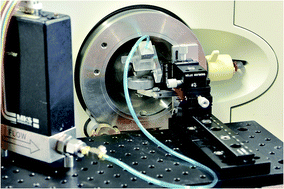A low-cost ambient desorption/ionization source for mass-spectrometry based on a dielectric barrier discharge
Abstract
An ambient ionization source for mass-spectrometry is described. It is based on a plasma generated in helium by a dielectric barrier discharge using two external electrodes arranged axially on a fused silica tube. The plasma is created with a sinusoidal voltage source having an amplitude of 7 kilovolts and a frequency of 27 kilohertz. The plasma cell as well as the excitation circuitry were designed with simplicity in mind and both can easily be duplicated. The plasma source was characterized in terms of electronic properties and temperatures by using optical emission spectroscopy. Bands of the nitrogen second positive system at 357 nm were used for determination of the vibrational and rotational temperatures by fitting simulated to the experimental spectra with the software package Specair. With an excitation voltage of 7 kilovolts and a flow rate of 50 mL min−1, a vibrational temperature of approximately 5000 K and a rotational temperature of 300 K were determined. By using the Boltzmann plot method, the excitation temperature was determined to be around 2800 K. The performance of the ionization source was demonstrated by the qualitative analysis of various standards as well as of application examples of pharmaceutical, illegal drug and food samples. Quantitative analysis of solutions is also possible. Linear calibration curves were obtained for caffeine and nicotine in the range from 1 to 1500 μM and limits of detection of 0.8 μM and 0.4 μM were determined for the two compounds respectively.



 Please wait while we load your content...
Please wait while we load your content...